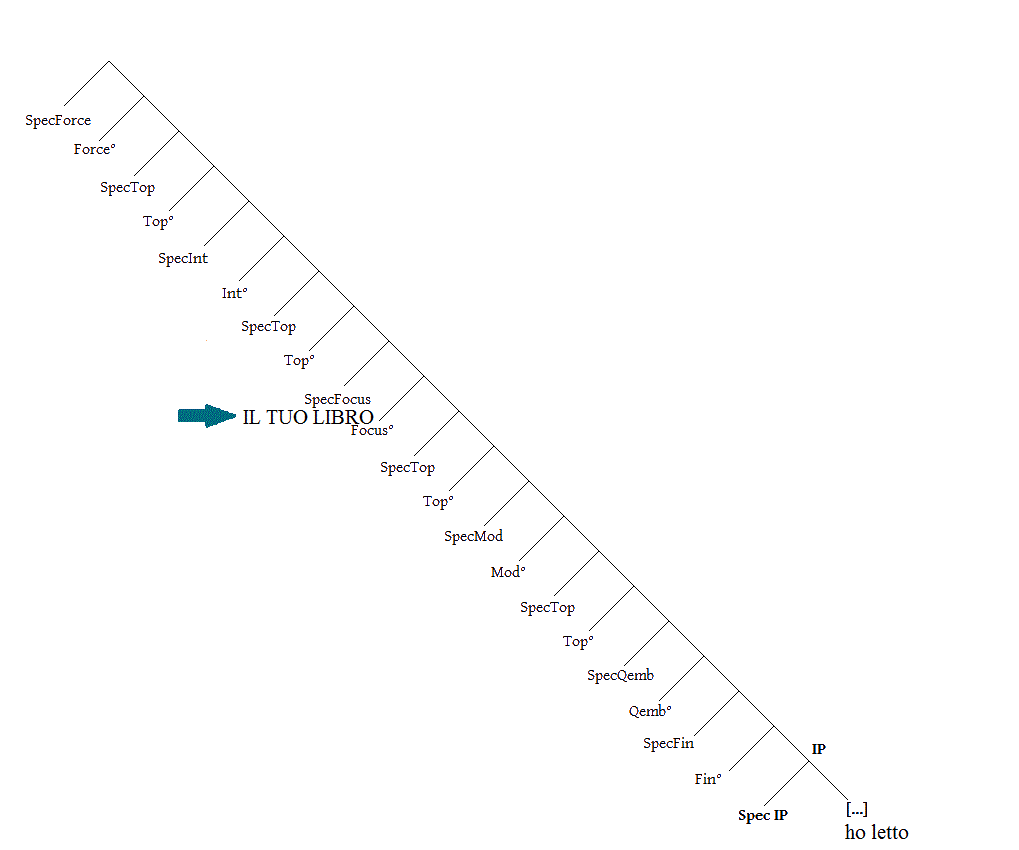Focus Phrase (FocP)
♦ Given the configuration Spec - head - complement the head of the functional FocP projection is a Foc head, a focalized phrase is in the Spec position and the presupposition (i.e. what is old/presupposed in the clause following the focalized phrase) fills the complement position. The Focus projection is the landing site of focalized elements bearing the +Foc feature.
♦ The Foc head is unique in the Left Periphery; its uniqueness might follow from interpretative properties of the structure, as stated in a first rudimentary form in the following interpretative instruction: ''if a FocP was recursively embedded as the complement of a higher Foc, we would have that the complement of a higher Foc head contains a Focus position, an inconsistent interpretative property. An element cannot be simultaneously focused and a component of the presupposed part'' (Rizzi 2013: 212).
♦ According to Bianchi, Bocci & Cruschina (2013), a typology of Focus exists: Corrective, Mirative and New Information Focus. In Italian, for example, the functional projection in the CP hosts Corrective and Mirative Focus, whereas New Information Focus occupies a lower clause internal position in the Periphery of the vP (Belletti 2004). In other grammatical systems, such as Sicilian (Cruschina 2012), left peripheral FocP can also be the landing site for New Information Focus. Left peripheral and clause internal focus positions are also exploited in different types of clefts, as proposed in Belletti (2009, 2015).
♦ As illustrated in (1) for Italian, clitic resumption of a focused phrase is not possible within the following IP (contrary to what happens with Topics, see here):
(1) IL TUO LIBRO ho letto (, non il suo)
Your book I read (, not his)
(Italian, Rizzi 1997: 286; 4)
♦ Finally, as illustrated in (2), Focus and wh-items cannot co-occur; plausibly they are candidates for the same position.
(2) a. *A GIANNI che cosa hai detto (, non a Piero) ?
‘’TO GIANNI what did you tell (, not to Piero)
b. *Che cosa A GIANNI hai detto (,non a Piero) ?
‘’What TO GIANNI did you tell (, not to Piero) ?
(Italian, Rizzi 1997: 291)
♦ In various languages of the world showing overt realization of the Focus head, like e.g. Gungbe, there is straightforward evidence that “such particles are confined to the left periphery. “Gungbe not allow for multiple wh-questions or bona fide in situ questions, but it does permit wh-in situ echo questions like (3). In this case, the wh-phrase, while undoubtedly focal, cannot bear the focus marker. This would not be expected if wè was a DP-internal marker, while it follows from the view that wè is a DP-external left peripheral head, attracting wh-phrases and other focal elements” (Rizzi 2013: 204):
(3) a. fíté wè é yì?
‘Where foc he went?’
b. é yì fíté (*wè)?
‘he went where (foc)?’
(Gungbe, from Rizzi 2013: 204; 6)
Main References : Belletti A. (2004), Bianchi V., Bocci G. & Cruschina S. (2013), Cruschina S. (2012),
Rizzi L. (1997), Rizzi L. (2013),

